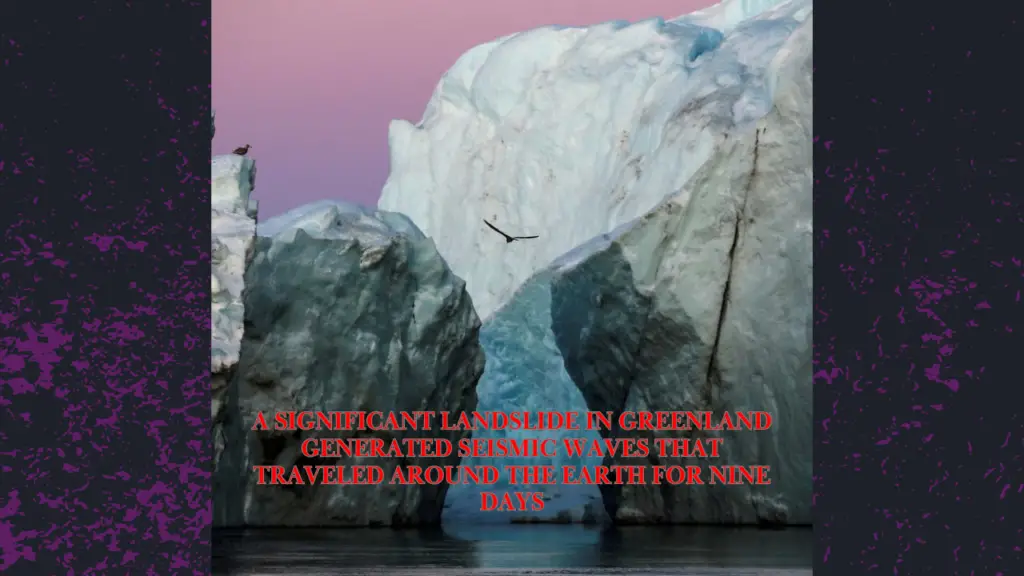One year ago, approximately 25 million cubic meters of ice and rock fell into Greenland’s Dickson Fjord, displacing enough water to create a 200-meter high mega-tsunami. This event, triggered by a melting glacier, caused seismic waves that were felt globally, and researchers caution that similar occurrences could happen again.
On September 16, 2023, seismic stations around the world picked up a peculiar signal that puzzled scientists. While earthquakes are common, with 1,712 recorded globally in 2023 alone, these particular seismic waves were distinct, indicating that they were not caused by earthquakes. Remarkably, these waves continued to resonate for an astonishing nine days.
An Unusual Signal
Stephen Hicks, a computational seismology research fellow at University College London, along with Kristian Svennevig, a senior researcher at the Geological Survey of Denmark and Greenland, noted in a recent article that sensors detected the unusual signal from the Arctic to Antarctica. Their findings were published in the journal Science on September 12.
Unlike the complex sounds produced by multiple earthquake waves, this signal resembled a single frequency, similar to a violin string being plucked. This characteristic is atypical for seismic activity. Initially, the researchers classified the signal as an “unidentified seismic object” (USO). The prolonged duration of the signal—lasting for nine days—further confused scientists, as typical earthquake vibrations produce aftershocks that fade more rapidly.
Unraveling the Mystery
To investigate this phenomenon, over 68 researchers from 40 universities across 15 countries collaborated, utilizing various datasets and computer simulations. Ultimately, they determined that the waves originated from a massive landslide along the Dickson Fjord in Greenland.
According to Hicks and Svennevig, piecing together the mystery required integrating diverse evidence, including seismic data, satellite imagery, water level monitors in the fjord, and detailed simulations of water reactions. The team even accessed a classified bathymetric map of the fjord from the Danish Navy, taking nearly a year to assemble all the necessary information.
The Landslide and Its Impact
A fjord is a geological feature formed by glaciers eroding a valley below sea level, often characterized by U-shaped channels surrounded by steep cliffs. The landslide began with the collapse of Hvide Støvhorn peak, located about 1.2 kilometers from the fjord, resulting in a rock-ice avalanche. This event led to a submarine landslide, where approximately 25 million cubic meters of ice and rock—enough to fill 10,000 Olympic-sized swimming pools—plummeted into the fjord, generating a 200-meter-high mega-tsunami, nearly three times the height of the Srirangam Temple in Tamil Nadu.
Although the mega-tsunami did not result in fatalities, it damaged an unstaffed research facility on Ella Island, located about 72 kilometers away, along with some culturally and archaeologically significant sites in the region.
In contrast to ocean tsunamis, which spread out and dissipate, the waves in the narrow fjord (540 meters deep and 2.7 kilometers wide) reflected back and forth between the cliffs. This phenomenon, known as a seiche, peaked at nearly 110 meters in height. About five minutes after the landslide, the waves settled into a seiche with a maximum amplitude of 7.4 meters and a dominant frequency of 11.45 MHz, oscillating every 90 seconds.
For over nine days, the waves continued to oscillate, moving side to side approximately 10,000 times. These oscillations matched the unusual signals recorded by seismic stations worldwide.
A Global Resonance
The ice-rock avalanche and the subsequent wave motions caused the Earth’s surface to resonate like a gong, producing global reverberations. Researchers also investigated the cause of the massive landslide, finding that the glacier’s melting had weakened the rocky slopes. Satellite imagery and other data indicated that the glacier’s base had been rapidly receding in recent decades due to global warming. As the ice melted, it could no longer support the weight above, leading to the violent rockslide and the resulting mega-tsunami.
“This is a stark reminder that we are navigating uncharted waters,” Hicks and Svennevig remarked. “Just a year ago, the idea that a seiche could persist for nine days would have been dismissed as absurd. Similarly, a century ago, the idea that warming could destabilize slopes in the Arctic, resulting in significant landslides and tsunamis occurring almost yearly, would have seemed far-fetched. However, these once-unimaginable events are becoming a new reality.”
Future Implications
The landslide triggered by the melting glacier serves as a warning for potential future events. Arctic and subarctic regions are warming at rates two to three times faster than the rest of the planet. As ice melts, darker rock surfaces are exposed, absorbing more sunlight and accelerating the melting process. This trend suggests that the frequency of ice-related landslides may increase.
“This certainly won’t be the last mega-tsunami caused by a landslide,” Hicks and Svennevig cautioned. “As permafrost on steep slopes continues to warm and glaciers thin, we can anticipate similar events occurring more frequently and on a larger scale across the polar and mountainous regions of the world.”

